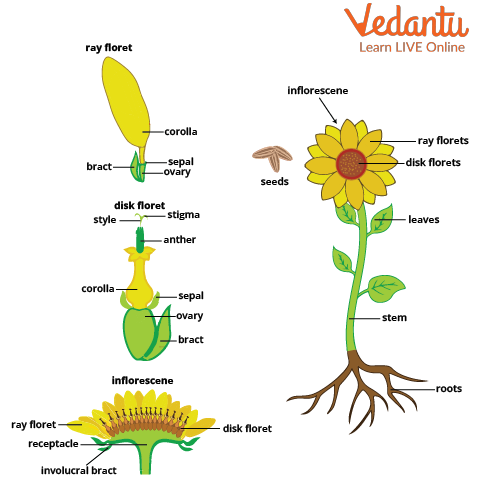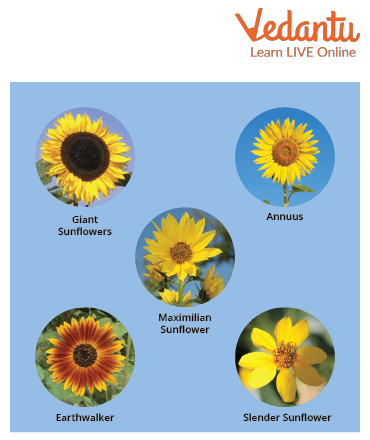An Overview of Sunflower
After soybean, sunflower is a significant oil seed crop. It contains between 46 and 52 percent oil. USSR, Bulgaria, Canada, and the United States are the top nations for sunflower cultivation. This crop was introduced to India in 1969 from the USSR. Sunflowers are perennial herbs. Perennial plants, which persist for two years or more, are often found in South America and portions of Central America. The genus Helianthus contains several different composite plants, including sunflowers. It has oil seeds, so this is used as a cash crop.
What is a Sunflower?
A sunflower is an oil-yielding plant. Since sunflowers are planted for decorative purposes, they are referred to as "surajmukhi." After soybean, rapeseed, and mustard, it is the world's third largest oilseed crop in India.
It grows in sunny areas and short duration crops. Its solitary stem and enormous flowers set it apart from all other cultivated plants. The capitulum is the inflorescence. It has a flower that is bisexual. Its nature is protandrous. Early in the morning (6–10 am) is when flowering begins. The pollen grain's 12-hour vitality. The stigma's susceptibility might last for 2–3 days.
In the sunflower growth cycle, during which the initial couple of leaves are in opposition to one another, as the plant grows new leaves, they are positioned along the stem in an alternate pattern and 2 to 3 leaves appear each week. Initially, the leaf grows in the opposite direction and then starts growing alternatively, with the growth in the plant.

A Sunflower
Sunflower Scientific Name
The scientific name of sunflowers is Helianthus annuus. The classification of sunflower is given below:
Division: Phanerogams
Class: Dictoyledanae
Sub Class: Gamopetalae
Order: Asterase
Family: Asteraceae
Genus: Helianthus
Species: Annuus
Family of Sunflower
The sunflower species belong to the asteraceae family. The Asteraceae are the most numerous flowering plant families. The plants in this family have an inflorescence capitulum. The capitulum is flat in sunflowers. Flowers are known as florets. Florets are sessile, tubular, or ligulate. Disc and ray florets are present in Helianthus annus. The plants in this family have cypsela type fruit. Plants of this family are used as oils, perfumes, dyes, rubber, and also as ornamental plants.
Sunflower Species
It includes species that are diploid, tetraploid, and hexaploid. More than 67 species of Helianthus exist, of which two are domesticated. Helianthus annuus (sunflower, diploid, 2n=34) is grown for oilseed. Helianthus tuberosus (hexaploid, 2n = 104) is cultivated for its tubers. Shweinitz’s sunflower (Helianthus schweinitzii) is the rarest species of sunflower.
Different Types of Sunflower
There are too many types of sunflowers that are grown in field parks. There are different types of sunflowers on the basis of their height and colour. There are some plants that are tall and some that are dwarf, while some differ in colour.
Tall Plants
Some plants reach a height of around 12 feet, and some are hybrids, while some are native plants. The giant forms are 6 to 14 feet tall. These plants show late development, have large seeds with white, grey, or black striped heads, and are 12 to 30" in diametre. Very little oil is present. Some of the examples include Mammoth Russian, American giant sunflower, Shweinitz’s sunflower, etc.
Shweinitz’s Sunflower (Helianthus Schweinitzii)
It is an American sunflower species and its height is around 16-17 feet. These are light, bright yellow coloured flowers.
American Giant Sunflower (Helianthus Snnuus ‘American Giant‘)
It is a hybrid plant and grows in some harder climatic conditions, such as fast wind.
Skyscraper Sunflower (Helianthus Annuus ‘Skyscraper‘)
Its name implies that it is a sky touching plant. It has a thick and durable stalk in the wind.
Mammoth Russian Sunflower (Helianthus Annuus ‘Russian Mammoth‘)
It is the tallest and oldest type of sunflower. This type has thick and stable stems. Their seeds are used by some organisms, such as squirrels in the winter season.
Dwarf plants are grown in gardens and are considered as indoor plants.
Pacino Sunflower (Helianthus Annuus ‘Pacino Cola’)
Firecracker Sunflower (Helianthus Annuus ‘Firecracker’)
Coloured Sunflowers
Earthwalker sunflower, Terracotta sunflower, and Moulin Rouge sunflower (because of their vibrant burgundy crimson petals and continuous colour; sunflowers with these colours are among the most unusual.)
Ruby Eclipse Sunflower

Different Types of Sunflowers
Sunflower Plantation
The states of North Punjab, Haryana, Western Gujarat, Southern Andhra Pradesh, Tamil Nadu, and Karnataka are included in the cultivation zone. Both a double crop and a full-season crop of sunflower may be raised. As a double crop, it is particularly appealing from an economic perspective.
The crop needs a chilly temperature for seed germination and growth, while warm, sunny weather is needed for flowering. Since it is a photo-insensitive crop, it may be cultivated year-round. These plants can tolerate a variety of soil pH levels. From 5.7 to 8.0 is the pH range that sunflowers can withstand. Sunflowers may be grown in fields used for row crops.
Seeding depth for dense soils should be one to five inches. Sunflowers require a high seeding rate of 17,000 seeds per acre. Plantings in April or May often provide a larger yield than those in June or July. Need for temperature: If the seed is of excellent quality, sunflowers may sprout and emerge from soils as chilly as 46 oF. A mature sunflower can endure temperatures as low as 25 oF. The ideal range of daily mean temperatures for growth is between 18 and 25 oC. The width of the row has been better between 20 and 30 inches, but widths as wide as 40 inches and as narrow as 14 inches have produced good yields.
Conclusion
The sunflower’s botanical name is Helianthus annuus. Sunflowers are typically tall annual or perennial plants that can reach heights of 300 cm (120 in) or higher in some varieties. Sunflower is a group of flowers, not a single flower. What looks to be a single flower is actually an inflorescence, which is a collection of tiny blooms. These flowers are artistically arranged in a container. The term "capitulum" refers to this kind of inflorescence.


FAQs on Sunflower Scientific Name
1. Why do sunflower plants take a lot of water?
The sunflower plant grows in the sunny season, and it requires direct sunlight. These plants grow at high temperatures. Due to more sunlight, there is more evaporation of water. So, these plants consume a lot of water during the growing and flowering season. They bloom only in the sunny season because these are long day plants. The absorbed water is lost through evaporation and only a small quantity is present for plant use. So, it takes more and more water to grow and reduce the risk of drying up due to evaporation.
2. How is a sunflower a cash crop?
The sunflower plant is grown as a cash crop throughout the world. The cash crops are grown in high yield and are used to earn money. These crops help earn money, so they are called cash crops. The sunflower is an oil yielding crop, and its seeds have a lot of oil that is used for many purposes, such as vegetable oils. The seeds of sunflowers are also used as a source of nutritive value. These seeds are exported to low yielding countries from high yielding countries and help to improve the economy of the growing country.
3. Why are sunflower seeds healthy to eat?
The seeds of sunflowers are more nutritious and are used as food in some countries. Unsaturated fatty acids, high-quality protein, calcium, magnesium, potassium, phosphorus, selenium, vitamin E, vitamin B1, and other minerals may all be found in abundance in sunflower seeds. These seeds are used in snacks, salads, and as a roasted form. There are many vitamins that help with immune boosting. Tryptophan, an amino acid, is abundant in sunflower seeds and tryptophan's antidepressant properties. These seeds help to reduce cardiovascular diseases and increase metabolism and growth.










